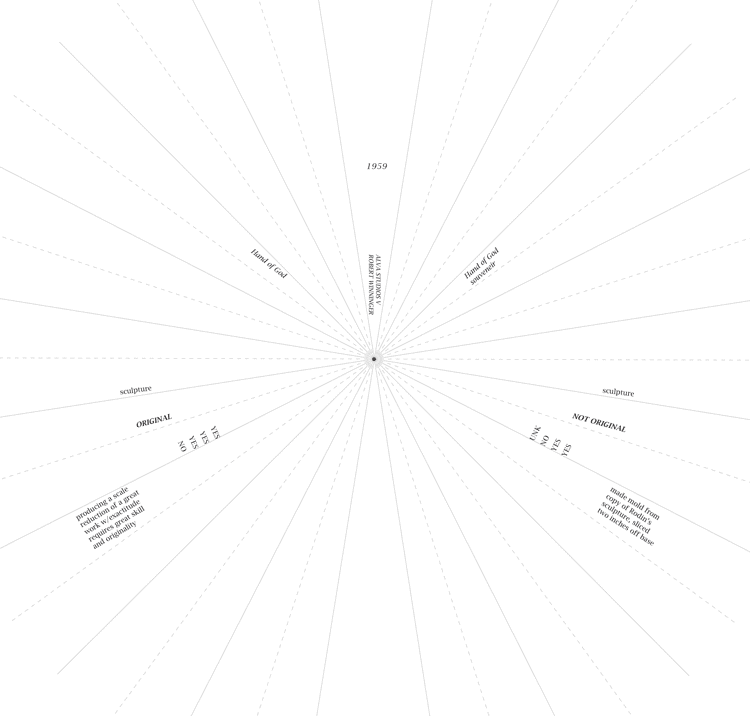Art and Law Studies, 2010
Three projects exploring the search for order in ambiguous legal and ethical situations.

Originality Compass, 2010
From hundreds of cases around copyright infringement, twenty were selected across a spectrum of creative forms such as: photography, sculpture, painting, and song lyrics. These cases were catalogued by the title of the work and the method used to make the work, for instance made by hand vs. manufactured. Each case was also coded by if the work in question was seen as transformative or not original. By breaking apart pages of court decisions into these specific elements, the cases could be arranged on a volvelle (or wheel chart, similar to color wheel).

The volvelle presents a new relational system that facilitated novel interpretations to intellectual property debates and reveals contradictions between these cases. For instance, in one case a designer was guilty of infringement for copying a dog mannequin, whereas in another case a designer copying another designer’s human mannequin was not a violation of copyright. Through examples like these, the chart exposed the ambiguity in defining “originality” and highlighted the challenges for creative practitioners who make original work or work that involves sampling and cultural critique.

I’m Sorry, 2010

I’m Sorry, explores originality in the context of appropriation and plagiarism. The text of the book consists of excerpts from public apologies for plagiarism by journalists, authors, and politicians combined into one long, rambling apology. The layout of the text is composed from setting the type by hand – one letter at a time– for printing on the Vandercook press.

Each page represents a pass on the antique press and includes errors inherent to the hand set type process, such as physically damaged type where letters are missing parts or type that was hand set upside-down or backwards. The combined apology takes up twenty lines and is re-printed on each page until gradually all printing errors have been corrected. The repeated text on the sequnce of booklet pages becomes a physical embodiment for the theme of exposure to other’s ideas and the slippery slope between influence, appropriation, and outright “theft.”
The book was letterpress printed at The Center for Book Arts. Edition of 35.
You Don’t Need a Weatherman, 2013

This diagram is based on Alex B. Long’s research in the use of pop metaphors in legal proceedings with emphasis on Bob Dylan. In his paper The Freewheelin’ Judiciary: A Bob Dylan Anthology, he cites how Dylan lyrics have found their way into published court documents. For example Chief Justice John Roberts’ opinion on payphone operators and carrier long distance charges quotes “When you ain’t got nothing, you got nothing to lose.” Justice Antonin Scalia’s opinion on the court’s ability to decide on employee privacy in regard to text messages quotes “These times they are a changin.’”
This chart focuses on citations for Dylan’s Subterranian Homesick Blues, more specifically the couplet:
“You don‟t need a weatherman
To know which way the wind blows.”
A search through court documents where these lines were quoted turned up over twenty results. Weatherman, diagrams these cases and the context that the Dylan lyrics were used to decribe. The lines and connections are styled similar to a weather forecast and offer a window into the ways art was used as legal precedent.
One Response
Comments are closed.